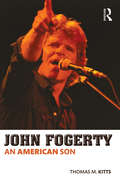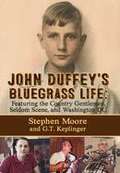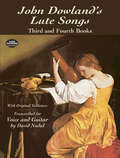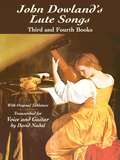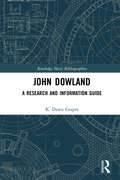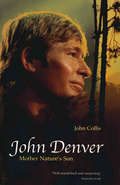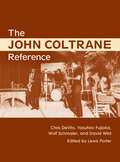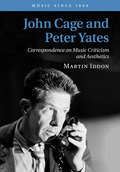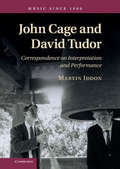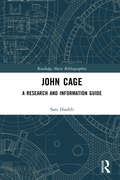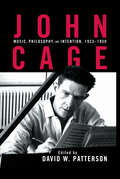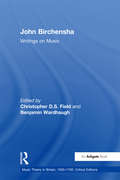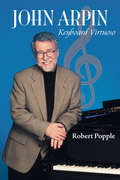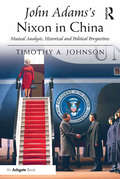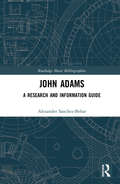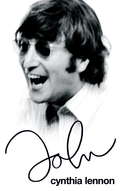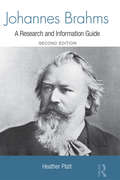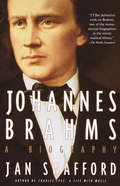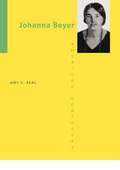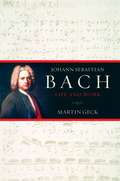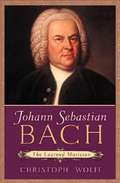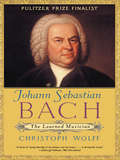- Table View
- List View
John Lennon: Young Rock Star (Easy Biographies)
by Laurence SantreyA brief biography of the English rock musician with emphasis on his early years and the formation of the famous Beatles.
John Hartford, Pilot of a Steam Powered Aereo-Plain
by Andrew VaughanIn 1971, John Hartford turned his back on a thriving Hollywood career and returned to his bluegrass roots to make one the finest albums of the decade. Circumstance and fate brought him a set of wonderfully skilled musicians that played with fire and passion and in such harmony that the sum of the musical parts was always going to be beyond anything Hartford could have imagined. Not only was Aereo-Plain a remarkable record in its own right, filled with great songs and astounding musicianship, but it stretched the boundaries of bluegrass and opened the doors to a new genre of country and folk music, newgrass. Of course, as with most pioneering albums, Aereo- Plain was a commercial disaster, but now more than forty years later it remains one of the most influential records in acoustic music history. The long hair and beard John Hartford revealed on the album's cover signaled his rejection of the clean cut TV performer who had become internationally known both for his classic song "Gentle on My Mind," and regular TV appearances alongside the Smothers Brothers and Glen Campbell. About the Author Andrew Vaughan is respected Nashville-based writer and an authority on country music. As a music critic, his work has appeared in Billboard, Music Week, Mojo, Q, the London Times, the Guardian, Folk Roots, and many other magazines. He was founding editor of Country Music International magazine and a regular guest on BBC Radio, BBC TV and VH1 as an expert on country music and country rock. In 1999, Andrew moved from London to Nashville, where he quickly became one of the best-connected writers on the music scene. He is the author of several books including Shania: Feel Like a Woman (Andre Deutsch) and The Eagles: An American Band (Sterling Books). He has been a record industry consultant and editorial director for the American Music Channel since 2002.
John Fogerty: An American Son
by Thomas M. KittsThis is the first critical biography to explore John Fogerty's life and his music. When inducting Creedence Clearwater Revival into the Rock and Roll Hall of Fame in 1993, Bruce Springsteen referred to the "music’s power and its simplicity… [its] beauty and poetry and a sense of the darkness of events and of history, of an American tradition shot through with pride, fear, and paranoia." This book investigates those aspects and more of Fogerty’s songs and life: his Americanism, his determined individualism, and unyielding musical vision which led to conflicts with his band, isolation from his family, constant legal battles, and some of the greatest songs of the 20th century.
John Duffey’s Bluegrass Life: Featuring the Country Gentlemen, Seldom Scene, and Washington, D.C.
by Stephen Moore G. T. KeplingerIt has been 22 years since we lost the great John Duffey, the father of modern bluegrass music. He still looms large in the minds of those who knew him and those who saw him perform. Those who came to love bluegrass since never got the chance to experience his power first-hand. Hopefully, this book will give them an understanding of the unique larger-than-life character that was John Duffey. Fortunately, there are plenty of recordings and some videos still available to give a clue. John’s creative influence is heard and felt in the two main bands that he fronted, The Country Gentlemen and The Seldom Scene. These bands created the Washington sound, a newer, more cosmopolitan approach to a genre that had been invented by rural southern and Appalachian musicians in the 1940s. John co-founded The Country Gentlemen in 1957, stayed with them until 1969. In 1971, he was coaxed back into performing to help found The Seldom Scene. John remained with the Scene until his death in December 1996. I have been fortunate to have been a band mate of John’s in both of those bands. There are so many Duffey stories that need to be retold lest they be lost. This book will help fill the void and make him come alive in the minds of the reader.” -- Tom Gray, BLUEGRASS MUSIC HALL OF FAMER Stephen Moore has co-authored four books, Helen Hayes: A Bio-Bibliography, Johnny Holliday: From Rock to Jock, Hoop Tales: Maryland Terrapins, and Cerphe's Up. A research technologist at Georgetown University, he plays in the Maryland rock cover band The Razors. G.T. Keplinger is a long-time bluegrass fan, historian, and archivist. His MFA thesis project was a documentary on The Seldom Scene. An Associate Professor of film at Stevenson University, he lives in Towson, MD with his wife, two children, and their long-haired dachshund.
John Dowland's Lute Songs: Third and Fourth Books with Original Tablature (Dover Song Collections)
by John DowlandOne of the few English musicians whose fame as a composer spread throughout Europe during his lifetime, John Dowland (1563–1626) was also unsurpassed in his day as a lute virtuoso. The composer of 88 lute songs, Dowland had twice applied for the position of lutenist at the court of Elizabeth I and was rejected both times — for religious reasons, it was thought. (He had converted to Catholicism during a Protestant reign.) His talents, however, were welcomed at courts in Germany, Venice, Florence, and Denmark. Since the early 20th century, Dowland's excellence as a song writer has been well established; and many of his compositions for lute — long shrouded in obscurity — have become well known.This collection of 45 songs includes all the works in his original Third Booke of Songs or Aires; in A Pilgrime's Solace (his fourth collection); three contributions to his son Robert's A Musicall Banquet; plus a lovely galliard — a dance for solo guitar.Together with Nadal's Lute Songs of John Dowland (First and Second Books), published in 1997, this compilation completes Dover's newly edited and engraved editions of Dowland's lute songs — a rich oeuvre sure to be studied and enjoyed by singers, guitarists, and music lovers alike.
John Dowland's Lute Songs: Third and Fourth Books with Original Tablature
by John Dowland David NadalOne of the few English musicians whose fame as a composer spread throughout Europe during his lifetime, John Dowland (1563-1626) was also unsurpassed in his day as a lute virtuoso. The composer of 88 lute songs, Dowland had twice applied for the position of lutenist at the court of Elizabeth I and was rejected both times -- for religious reasons, it was thought. (He had converted to Catholicism during a Protestant reign.) His talents, however, were welcomed at courts in Germany, Venice, Florence, and Denmark. Since the early 20th century, Dowland's excellence as a song writer has been well established; and many of his compositions for lute -- long shrouded in obscurity -- have become well known.This collection of 45 songs includes all the works in his original Third Booke of Songs or Aires; in A Pilgrime's Solace (his fourth collection); three contributions to his son Robert's A Musicall Banquet; plus a lovely galliard -- a dance for solo guitar.Together with Nadal's Lute Songs of John Dowland (First and Second Books), published in 1997, this compilation completes Dover's newly edited and engraved editions of Dowland's lute songs -- a rich oeuvre sure to be studied and enjoyed by singers, guitarists, and music lovers alike.
John Dowland: A Research and Information Guide (Routledge Music Bibliographies)
by K. Dawn GrapesJohn Dowland: A Research and Information Guide offers the first comprehensive guide to the musical works and literature on one of the major composers of the English Renaissance. Including a catalog of works, discography of recordings, extensive annotated bibliography of secondary sources, and substantial indexes, this volume is a major reference tool for all those interested in Dowland's works and place in music history, and a valuable resource for researchers of Renaissance and English music.
John Denver: Mother Nature's Son
by John CollisJohn Denver was America's biggest-selling solo star of the '70s. In commercial terms he was on a par with Sinatra in the '40s, Elvis in the '50s and the Beatles in the '60s. He experimented with a variety of styles and won fans from such diverse worlds as folk, pop and country music. Beneath the often tranquil surface of his music and his clear, clean tenor voice, however, lurked a darker side to Denver's character. The writer of 'Annie's Song', one of the most straightforward and personal expressions of love, became a wife-beater. The man who cavorted with the Muppets was an alcoholic. The committed environmentalist had his own plane, the most polluting form of transport. John Collis has delved deep to discover exactly who John Denver was. By unravelling the complexities of the singer's personality and background, he reveals Denver as a complicated, contradictory man, much more intriguing than the sometimes placid surface of his music might suggest. Millions of people around the globe found something in his music that touched their souls; Collis, by charting Denver's career and development as an artist, explores his legendary contribution not only to the world of music but also to the society of which he was a protagonist and a victim.
The John Coltrane Reference
by Lewis Porter Chris DeVito David Wild Yasuhiro Fujioka Wolf SchmalerThe BBC's Jazz Book of the Year for 2008. Few jazz musicians have had the lasting influence or attracted as much scholarly study as John Coltrane. Yet, despite dozens of books, hundreds of articles, and his own recorded legacy, the "facts" about Coltrane's life and work have never been definitely established. Well-known Coltrane biographer and jazz educator Lewis Porter has assembled an international team of scholars to write The John Coltrane Reference, an indispensable guide to the life and music of John Coltrane. The John Coltrane Reference features a a day-by-day chronology, which extends from 1926-1967, detailing Coltrane's early years and every live performance given by Coltrane as either a sideman or leader, and a discography offering full session information from the first year of recordings, 1946, to the last, 1967. The appendices list every film and television appearance, as well as every recorded interview. Richly illustrated with over 250 album covers and photos from the collection of Yasuhiro Fujioka, The John Coltrane Reference will find a place in every major library supporting a jazz studies program, as well as John Coltrane enthusiasts.
John Cage and Peter Yates: Correspondence on Music Criticism and Aesthetics (Music since 1900)
by Martin IddonThe correspondence between composer John Cage and Peter Yates represents the third and final part of Cage's most significant exchanges of letters, following those with Pierre Boulez and with David Tudor. Martin Iddon's book is the first volume to collect the complete extant correspondence with his critical friend, thus completing the 'trilogy' of Cage correspondence published by Cambridge. By bringing together more than 100 letters, beginning in 1940 and continuing until 1971, Iddon reveals the dialogue within which many of Cage's ideas were first forged and informed, with particular focus on his developing attitudes to music criticism and aesthetics. The correspondence with Yates represents precisely, in alignment with Cage's fastidious neatness, the part of his letter writing in which he engages most directly with the last part of his famous tricolon, 'composing's one thing, performing's another, listening's a third'.
John Cage and David Tudor
by Martin IddonJohn Cage is best known for his indeterminate music, which leaves a significant level of creative decision-making in the hands of the performer. But how much licence did Cage allow? Martin Iddon's book is the first volume to collect the complete extant correspondence between the composer and pianist David Tudor, one of Cage's most provocative and significant musical collaborators. The book presents their partnership from working together in New York in the early 1950s, through periods on tour in Europe, until the late stages of their work from the 1960s onwards, carried out almost exclusively within the frame of the Merce Cunningham Dance Company. Tackling the question of how much creative flexibility Tudor was granted, Iddon includes detailed examples of the ways in which Tudor realised Cage's work, especially focusing on Music of Changes to Variations II, to show how composer and pianist influenced one another's methods and styles.
John Cage: A Research and Information Guide (Routledge Music Bibliographies)
by Sara HaefeliThis annotated bibliography uncovers the wealth of resources available on the life and music of John Cage, one of the most influential and fascinating composers of the twentieth-century. The guide will focus on documentary studies, archival resources, scholarly research, and autobiographical materials, and place the composer and his work in a larger context of postmodern philosophy, art and theater movements, and contemporary politics. It will support emerging scholarship and inquiry for future research on Cage, with carefully selected sources and useful annotations.
John Cage: Music, Philosophy, and Intention, 1933-1950 (Studies In Contemporary Music And Culture Ser.)
by David W. PattersonJohn Cage seeks to explore the early part of the composer's life and career, concentrating on the pre-chance period between 1933 and 1950 that is crucial to understanding his later work. The essays consider Cage's influences, his evolving aesthetic, and his movement toward ideology that would later shape his work.
John Birchensha: Writings On Music (Music Theory In Britain, 1500-1700: Critical Editions Ser.)
by Benjamin WardhaughJohn Birchensha (c.1605-?1681) is chiefly remembered for the impression that his theories about music made on the mathematicians, natural philosophers and virtuosi of the Royal Society in the 1660s and 1670s, and for inventing a system that he claimed would enable even those without practical experience of music to learn to compose in a short time by means of 'a few easy, certain, and perfect Rules'-his most famous composition pupil being Samuel Pepys in 1662. His great aim was to publish a treatise on music in its philosophical, mathematical and practical aspects (which would have included a definitive summary of his rules of composition), entitled Syntagma music Subscriptions for this book were invited in 1672-3, and it was due to be published by March 1675; but it never appeared, and no final manuscript of it survives. Consequently knowledge about his work has hitherto remained extremely sketchy. Recent research, however, has brought to light a number of manuscripts which allow us at last to form a more complete view of Birchensha's ideas. Almost none of this material has been previously published. The new items include an autograph treatise of c.1664 ('A Compendious Discourse of the Principles of the Practicall & Mathematicall Partes of Musick') which Birchensha presented to the natural philosopher Robert Boyle, and which covers concisely much of the ground that he intended to cover in Syntagma music a detailed synopsis for Syntagma music hich he prepared for a meeting of the Royal Society in February 1676; and an autograph notebook (now in Brussels) containing his six rules of composition with music examples, presumably written for a pupil. Bringing all this material together in a single volume will allow scholars to see how Birchensha's rules and theories developed over a period of fifteen years, and to gain at least a flavour of the lost Syntagma music
John Arpin: Keyboard Virtuoso
by Robert PoppleBorn and raised in Port McNicoll, John Arpin discovered his musical talents early: at the age of four he could pick out tunes on the piano that he had heard on the radio; by ten, he had been identified as a child prodigy by a Royal Conservatory of Music adjudicator. He would go on to become one of Canada’s finest keyboard virtuosos, playing at concert halls around the world. Equally at ease performing solo piano concerts, being accompanied by a full symphony orchestra, jamming with jazz greats, or accompanying opera singers, he was, perhaps, best known as the premier ragtime pianist of his day. This authorized biography is based on more than 40 hours of conversation during the last four years of John’s life and supported by extensive research. Included are his friendships with Glenn Gould, Gordon Lightfoot, and others, his years as the designated artist for Yamaha, and his rise to prominence as a veteran of the concert stage. His stories represent pure Canadian music history.
John Adams's Nixon in China: Musical Analysis, Historical and Political Perspectives
by Timothy A. JohnsonJohn Adams's opera, Nixon in China, is one of the most frequently performed operas in the contemporary literature. Timothy A. Johnson illuminates the opera and enhances listeners' and scholars' appreciation for this landmark work. This music-analytical guide presents a detailed, in-depth analysis of the music tied to historical and political contexts. The opera captures an important moment in history and in international relations, and a close study of it from an interdisciplinary perspective provides fresh, compelling insights about the opera. The music analysis takes a neo-Riemannian approach to harmony and to large-scale harmonic connections. Musical metaphors drawn between harmonies and their dramatic contexts enrich this approach. Motivic analysis reveals interweaving associations between the characters, based on melodic content. Analysis of rhythm and meter focuses on Adams's frequent use of grouping and displacement dissonances to propel the music forward or to illustrate the libretto. The book shows how the historical depiction in the opera is accurate, yet enriched by this operatic adaptation. The language of the opera is true to its source, but more evocative than the words spoken in 1972-due to Alice Goodman's marvelous, poetic libretto. And the music transcends its repetitive shell to become a hierarchically-rich and musically-compelling achievement.
John Adams: A Research and Information Guide (Routledge Music Bibliographies)
by Alexander Sanchez-BeharJohn Adams: A Research and Information Guide offers the first comprehensive guide to the musical works and literature of one of the leading American composers of our time. The research guide catalogs and summarizes materials relating to Adams’s work, providing detailed annotated bibliographic entries for both primary and secondary sources. Covering writings by and interviews with Adams, books, journal articles and book chapters, newspaper articles and reviews, dissertations, video recordings, and other sources, the guide also contains a chronology of Adams’s life, a discography, and a list of compositions. Robust indexes enable researchers to easily locate sources by author, composition, or subject. This volume is a major reference tool for all those interested in Adams and his music, and a valuable resource for students and researchers of minimalism, contemporary American music, and twentieth-century music more broadly.
John
by Cynthia LennonCynthia and John Lennon's relationship spanned ten crucial years of the Beatles phenomenon. But as well as new insight into the Beatles years, Cynthia has a compelling personal story of marriage, motherhood and the man who was to become the most idolised and admired of all the Beatles.Cynthia is candid about the cruel and the loving sides of John. She tells of the end of their marriage and the beginning of his relationship with Yoko Ono in more detail than ever before, and reveals the many difficulties estrangement from John - and then his death - brought for herself and Julian. Cynthia is a remarkable survivor and this is her extraordinary story and unique insight into a man loved and idolised all over the world.
John
by Cynthia LennonCynthia and John Lennon's relationship spanned ten crucial years of the Beatles phenomenon. But as well as new insight into the Beatles years, Cynthia has a compelling personal story of marriage, motherhood and the man who was to become the most idolised and admired of all the Beatles.Cynthia is candid about the cruel and the loving sides of John. She tells of the end of their marriage and the beginning of his relationship with Yoko Ono in more detail than ever before, and reveals the many difficulties estrangement from John - and then his death - brought for herself and Julian. Cynthia is a remarkable survivor and this is her extraordinary story and unique insight into a man loved and idolised all over the world.
Johannes Brahms: A Research And Information Guide (Routledge Music Bibliographies)
by Heather PlattFirst published in 2011. Routledge is an imprint of Taylor & Francis, an informa company.
Johannes Brahms
by Jan SwaffordAn illuminating new biography of one of the most beloved of all composers, published on the hundredth anniversary of his death, brilliantly written by a finalist for the 1996 National Book Critics Circle Award. Johannes Brahms has consistently eluded his biographers. Throughout his life, he attempted to erase traces of himself, wanting his music to be his sole legacy. Now, in this masterful book, Jan Swafford, critically acclaimed as both biographer and composer, takes a fresh look at Brahms, giving us for the first time a fully realized portrait of the man who created the magnificent music. Brahms was a man with many friends and no intimates, who experienced triumphs few artists achieve in their lifetime. Yet he lived with a relentless loneliness and a growing fatalism about the future of music and the world. The Brahms that emerges from these pages is not the bearded eminence of previous biographies but rather a fascinating assemblage of contradictions. Brought up in poverty, he was forced to play the piano in the brothels of Hamburg, where he met with both mental and physical abuse. At the same time, he was the golden boy of his teachers, who found themselves in awe of a stupendous talent: a miraculous young composer and pianist, poised between the emotionalism of the Romantics and the rigors of the composers he worshipped--Bach, Mozart, Beethoven. In 1853, Robert Schumann proclaimed the twenty-year-old Brahms the savior of German music. Brahms spent the rest of his days trying to live up to that prophecy, ever fearful of proving unworthy of his musical inheritance. We find here more of Brahms's words, his daily life and joys and sorrows, than in any other biography. With novelistic grace, Swafford shows us a warm-blooded but guarded genius who hid behind jokes and prickliness, rudeness and intractability with his friends as well as his enemies, but who was also a witty drinking companion and a consummate careerist skillfully courting the powerful. This is a book rich in secondary characters as well, including Robert Schumann, declining into madness as he hailed the advent of a new genius; Clara Schumann, the towering pianist, tormented personality, and great love of Brahms's life; Josef Joachim, the brilliant, self-lacerating violinist; the extraordinary musical amateur Elisabet von Herzogenberg, on whose exacting criticism Brahms relied; Brahms's rival and shadow, the malevolent genius Richard Wagner; and Eduard Hanslick, enemy of Wagner and apostle of Brahms, at once the most powerful and most wrongheaded music critic of his time. Among the characters in the book are two great cities: the stolid North German harbor town of Hamburg where Johannes grew up, which later spurned him; and glittering, fickle, music-mad Vienna, where Brahms the self-proclaimed vagabond finally settled, to find his sweetest triumphs and his most bitter failures. Unique to this book is the way in which musical scholarship and biography are combined: in a style refreshingly free of pretentiousness, Jan Swafford takes us deep into the music--from the grandeur of the First Symphony and the intricacies of the chamber work to the sorrow of the German Requiem--allowing us to hear these familiar works in new and often surprising ways. This is a clear-eyed study of a remarkable man and a vivid portrait of an era in transition. Ultimately, Johannes Brahms is the story of a great, backward-looking artist who inspired musical revolutionaries of the following generations, yet who was no less a prophet of the darkness and violence of our century. A biographical masterpiece at once wholly original and definitive.From the Hardcover edition.
Johanna Beyer
by Amy C. BealComposer Johanna Beyer's fascinating body of music and enigmatic life story constitute an important chapter in American music history. As a hard-working German émigré piano teacher and accompanist living in and around New York City during the New Deal era, she composed plentiful music for piano, percussion ensemble, chamber groups, choir, band, and orchestra. A one-time student of Ruth Crawford, Charles Seeger, and Henry Cowell, Beyer was an ultramodernist, and an active member of a community that included now-better-known composers and musicians. Only one of her works was published and only one recorded during her lifetime. But contemporary musicians who play Beyer's compositions are intrigued by her originality. Amy C. Beal chronicles Beyer's life from her early participation in New York's contemporary music scene through her performances at the Federal Music Project's Composers' Forum-Laboratory concerts to her unfortunate early death in 1944. This book is a portrait of a passionate and creative woman underestimated by her music community even as she tirelessly applied her gifts with compositional rigor. The first book-length study of the composer's life and music, Johanna Beyer reclaims a uniquely innovative artist and body of work for a new generation.
Johann Sebastian Bach: Life and Work
by Martin Geck John HargravesGeck (musicology, Dortmund U., Germany) provides a study of Johann Sebastian Bach's life and music. He traces the career path the composer followed, from his early education to role as Kapellmeister of the St. Thomas Church in Leipzig and director of the collegium musicum. He then reserves half of the volume for an examination of Bach's music by genre, analyzing individual pieces and groups of vocal and instrumental works, and ends with brief discussions of specific topics such as Bach as a Christian, rhetoric and symbolism, proportion and numerical relations in his music, and theological research. The book has been translated from the German version by Hargraves (German language and literature, Yale U. and Connecticut College). Annotation ©2007 Book News, Inc., Portland, OR (booknews.com)
Johann Sebastian Bach: The Learned Musician
by Christoph WolffPublished on the 250th anniversary of the composer's death, this life history portrays Bach as the human being that he was, while bringing to bear all the advances gained in the last half-century of Bach scholarship. Wolff (professor of music, and dean of the Graduate School of Arts and Sciences, Harvard U.) demonstrates the intimate connection between the composer's life and his music, showing how Bach's superb inventiveness pervaded his career as musician, composer, performer, scholar, and teacher. He also provides a look at Bach's life and his surroundings, as well as how he fit into the broader context of the institutions, traditions, and influences of his time. Annotation c. Book News, Inc., Portland, OR (booknews.com)
Johann Sebastian Bach: The Learned Musician (Música/ma Non Troppo Ser.)
by Christoph WolffFinalist for the 2001 Pulitzer Prize in Biography, this landmark book was revised in 2013 to include new knowledge discovered after its initial publication. Although we have heard the music of J. S. Bach in countless performances and recordings, the composer himself still comes across only as an enigmatic figure in a single familiar portrait. As we mark the 250th anniversary of Bach's death, author Christoph Wolff presents a new picture that brings to life this towering figure of the Baroque era. This engaging new biography portrays Bach as the living, breathing, and sometimes imperfect human being that he was, while bringing to bear all the advances of the last half-century of Bach scholarship. Wolff demonstrates the intimate connection between the composer's life and his music, showing how Bach's superb inventiveness pervaded his career as musician, composer, performer, scholar, and teacher. And throughout, we see Bach in the broader context of his time: its institutions, traditions, and influences. With this highly readable book, Wolff sets a new standard for Bach biography.

